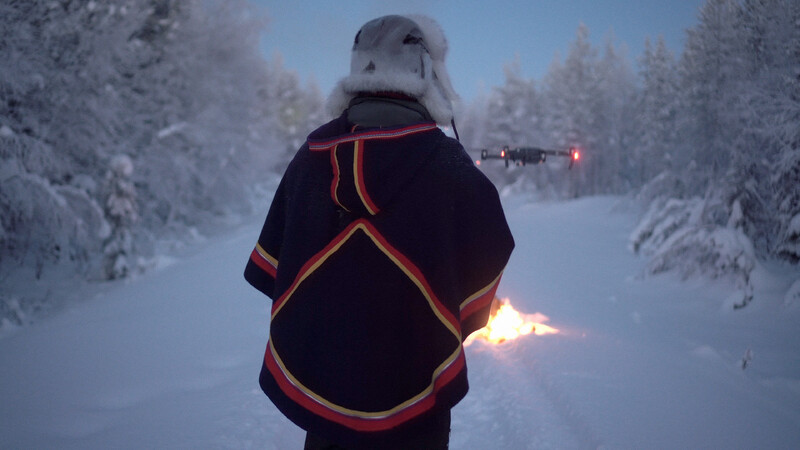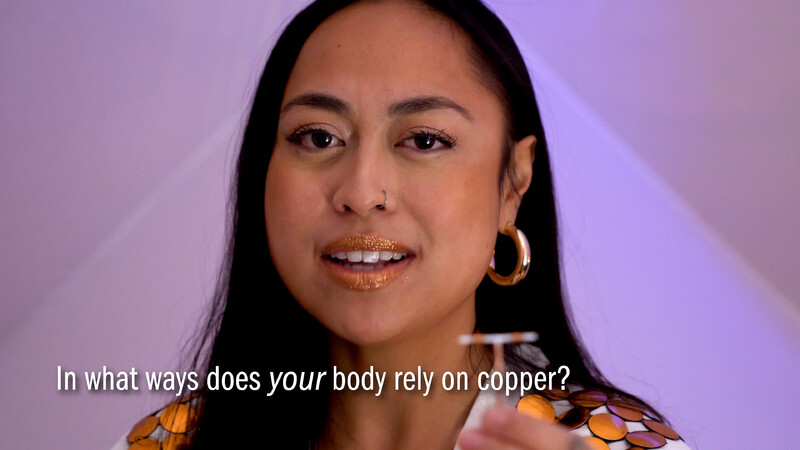
Part of GUT_BRAIN 1: Destructive Desires and Other Destinies of Excess, shis program of short videos by twelve artists explores Destructive Desires and their effects: extractivist capitalism, feminicide, remaindered populations, labour rights, the fallen dreams of modernization, metabolic rifts, penetrative potency, acts of bodily sovereignty, and healing rituals, and includes:
Tala Madani’s The Womb (2019) is an animation that depicts a fetus who can see the history of the world projected inside the womb and decides to take radical measures.
Patricia Domínguez’s Madre Drone (2019–20) is a mirage where a serpent-woman has a luminous encounter with a robot that could be human, delivering a kind of cosmic enunciation that connects us with recent student protests in Chile.
Laureana Toledo’s Order and Progress (2013–15) provides a visual history of the transformations of the Istmo de Tehuantepec—a geographic region that spans the states of Oaxaca and Veracruz—from the past forty years and links it to the fallen dreams of modernization, extractivism, and cultural colonization.
Miguel Ventura’s Mexican War Fair (2010), a sci-fi experimental video in which the artist imagines a dark future where peoples across Mesoamerica are colonized by a fascist regime that instrumentalizes language, high culture, and chocolate to indoctrinate its subjects.
Yoshua Okón’s Canned Laughter (2009) features a fictitious factory in which dozens of maquiladoras from Juárez were hired by the artist as consultants and performers, and instructed to generate different forms of laughter, destined to be canned in a factory, and exported and served to North American consumers.
Paloma Contreras Lomas’ Gold Fever (2023) is an experimental sex-melodrama that addresses the dark outcomes of political organization living on after the peak of syndicalism in the 1980s.
Tala Madani’s Overhead Projection (Crowd) (2018) is an animated comedy about the phallic domination of masculinity. In Madani’s work, slapstick humor is inseparable from violence and creation is synonymous with destruction, reflecting a complex and gut-level vision of contemporary power imbalances of all kinds.
Teresa Serrano’s La Piñata (2003) pictures a performance of feminicide, simultaneous male hate, and desire for the female body. Serrano uses the common childhood game of breaking a piñata that usually ends with a reward to construct an allegory of femicide that ends with no penalty.
Adrián Balseca’s Suspensión 1 (2019) features a performance allegorizing the modern desire for progress at the cost of extractivism and a metabolic rift with the earth. Balseca’s intervention recreates the games of “cucaña” (climbing pole) or “palo ensebado” (greasy stick) as a representation of colonialism and resource extraction in the Amazon.
Regina José Galindo’s La sombra (The Shadow) (2017) documents a performance in which the artist is persecuted by a military tank for as long as she can run, alluding to US military occupation and intervention in Central America. José Galindo dedicates this work to all women who go unnoticed and whose cries remain unheard.
Alberta Whittle’s business as usual: hostile environment: a REMIX (2021) explores the colonial history of the Fourth Clyde canal in central Scotland and the role of waterways in the voluntary and involuntary movement of people. This new iteration of the film includes ‘the horrors of COVID-19’ and the racial inequalities it has exposed.
Marisa Morán Jahn’s Snatchural History of Copper (2023) renders a multimedia project in which the artist traces “where the copper in my snatch comes from.” What unfolds is a cosmological exploration of a mineral that lives with(in) us and on which our households, cities, digital desires, and selves depend.
Alberta Whittle’s from the forest to the concrete (to the forest) (2019), reflects upon colonialism, climate change, inequality and the legacies of slavery in the context of the wreaking havoc on several Caribbean countries after hurricane Dorian.
Ignacio Acosta’s Litte ja Goabddá [Drones and Drums] (2016–18) examines the use of drone technologies in the protests by activists and Sámi people against a mining exploration project Gallák in Jåhkåmåhkke (Jokkomokk), Norrbotten Country, Sweden.
Screening Schedule
Tala Madani, The Womb, 2019. 3 min 26 sec. Courtesy David Kordansky Gallery, Los Angeles and New York City.
Patricia Domínguez, Madre Drone, 2019–20. 20 min 51 sec.
Laureana Toledo, Order and Progress, 2013–15. 15 min 45 sec.
Miguel Ventura, Mexican War Fair, 2010. 50 min 36 sec.
Yoshúa Okón, Canned Laughter, 2009. 8 min 50 sec.
Paloma Contreras Lomas, La Fiebre de Oro (Gold Fever), 2020. 23 min 31 sec.
Tala Madani, Overhead Projection (Crowd), 2018. 2 min 44 sec. Courtesy David Kordansky Gallery, Los Angeles and New York City.
Teresa Serrano, La Piñata, 2003. 6 min.
45 minute intermission (with catering)
Adrián Balseca, Suspension I, 2019. 5 min.
Regina José Galindo, La Sombra (The Shadow), 2017. 11 min.
Alberta Whittle, business as usual: hostile environment: a REMIX, 2021. 36 min. Courtesy The Modern Institute, Glasgow.
Marisa Morán Jahn: SNATCHural History of Copper, 2018. 1 min 50 sec.
Marisa Morán Jahn, SNATCHural History of Copper As Told Through 3 Objects, 2019. 2 min.
Alberta Whittle, from the forest to the concrete (to the forest), 2019. 10 min. Courtesy The Modern Institute, Glasgow.
Ignacio Acosta, Litte ja Goabddá [Drones and Drums], 2016–2018. Two-channel video screened on single channel. 18 min 19 sec.
Accessibility
Small World Music is located on the first floor of the Artscape Youngplace building, with a wheelchair ramp at the 180 Shaw Street doors, an elevator servicing every floor and a fully accessible washroom on every level. The venue has wheelchair accessible seating.
GUT_BRAIN Video Program (Part 1)
Small World Music Centre, Unit 101, Artscape Youngplace
180 Shaw St, Toronto
Artists: Ignacio Acosta, Adrián Balseca, Paloma Contreras Lomas, Patricia Domínguez, Regina José Galindo, Tala Madani, Marisa Morán Jahn, Yoshua Okón, Teresa Serrano, Laureana Toledo, Alberta Whittle, Miguel Ventura
Curated by Irmgard Emmelhainz and Christine Shaw
Video Stills



























- Artists
- Ignacio Acosta
- Adrián Balseca
- Paloma Contreras Lomas
- Patricia Domínguez
- Regina José Galindo
- Tala Madani
- Marisa Morán Jahn
- Yoshua Okón
- Teresa Serrano
- Laureana Toledo
- Miguel Ventura
- Alberta Whittle
In his work, these struggles are underlined by implementing mythological narratives that refer to the extraction of natural resources, and traditional notions of progress and development in capitalist culture. The research process behind each project ultimately reveals hidden histories in the folds of Latin American politics, dismantling colonial constructs. His analysis of specific social-environmental agendas within extractivist economies of modern history has led to a series of projects in a wide range of formats such as film, site-specific installation, sculptural objects, and photography, bringing to life ironic allegories on late capitalism. This production relies on a process of rigorous investigation and dynamic association, provoking unexpected references that include elements of popular culture, art history, and social history. Balseca’s projects synthesize complex contemporary landscapes while navigating the contradictions found within modernity’s promises.
Galindo received the Golden Lion for a Promising Young Artist in the 51st Venice Biennale (2005) for her works ¿Quién puede borrar las huellas? and Himenoplastia, which critique Guatemalan violence arising from misconceptions of morality and gender discrimination while demanding the restitution of the memory and humanity of the victims. In 2011 she was awarded the Prince Claus Award from the Netherlands for her ability to transform injustice and outrage into powerful acts that demand a response. She has also participated in the 49th, 53rd, and 54th Venice Biennials; Documenta 14 in Athens and Kassel; the 9th International Biennial of Cuenca; the 29th Biennial of Graphic Arts, Ljubljana; the Shanghai Biennial (2016); the Biennial of Pontevedra in 2010; the 17th Biennial of Sydney; the 2nd Biennial of Moscow; the First Triennial of Auckland; the 1st Biennial of Art and Architecture of the Canarian islands; the 4th Biennial of Valencia; the 3rd Biennial of Albania; the 2nd Biennial of Prague; and the 3rd Biennial of Lima.
Tala Madani has been the subject of solo exhibitions at a number of museums worldwide, including Tala Madani: Biscuits, the artist’s first North American survey at The Museum of Contemporary Art, Los Angeles (2023). Other solo exhibitions include Start Museum, Shanghai (2020); Mori Art Museum, Tokyo (2019); Secession, Vienna (2019); Portikus, Frankfurt (2019); La Panacée, Montpellier, France (2017); MIT List Visual Arts Center, Cambridge, Massachusetts (2016); Contemporary Art Museum St. Louis (2016); Nottingham Contemporary, England (2014); and Moderna Museet, Malmö and Moderna Museet, Stockholm, Sweden (2013). She recently participated in the 16th Istanbul Biennial: The Seventh Continent, Istanbul, Turkey (2019); Whitney Biennial 2017, Whitney Museum of American Art, New York; and Made in L.A. 2014, Hammer Museum, Los Angeles, among many other international group exhibitions. Madani’s work is in the permanent collections of institutions including Moderna Museet, Stockholm and Malmö, Sweden; Guggenheim Museum, New York; Museum of Contemporary Art, Los Angeles; Museum of Modern Art, New York; Stedelijk Museum, Amsterdam; Tate Modern, London; Mori Art Museum, Tokyo; and Whitney Museum of American Art, New York. Madani lives and works in Los Angeles.
- Curators
- Irmgard Emmelhainz
- Christine Shaw
Shaw’s work convenes, enables, and amplifies the transdisciplinary thinking necessary for understanding our current multi-scalar historical moment and co-creating the literacies, skills, and sensibilities required to adapt to the various socio-technical transformations of our contemporary society. She has applied her commitment to compositional strategies, epistemic disobedience, and social ecologies to multi-year curatorial projects including Take Care (2016–2019), an exhibition-led inquiry into care, exploring its heterogeneous and contested meanings, practices, and sites, as well as the political, economic, and technological forces currently shaping care; The Work of Wind: Air, Land, Sea (2015–2023), a variegated series of curatorial and editorial instantiations of the Beaufort Scale of Wind Force exploring the relentless legacies of colonialism and capital excess that undergird contemporary politics of sustainability and climate justice; and OPERA-19: An Assembly Sustaining Dreams of the Otherwise (2021–2029), a decentralized polyvocal drama in four acts taking up asymmetrical planetary crisis, differential citizenship, affective planetary attention disorder, and a strategic composition of worlds. She is the founding editor of The Society for the Diffusion of Useful Knowledge (Blackwood, 2018–ongoing), and co-editor of The Work of Wind: Land (Berlin: K. Verlag, 2018) and The Work of Wind: Sea (Berlin: K. Verlag, 2023).


The Blackwood
University of Toronto Mississauga
3359 Mississauga Road
Mississauga, ON L5L 1C6
[email protected]
(905) 828-3789
The galleries are currently closed.
Facebook | Twitter | Instagram
Sign up to receive our newsletter.
The Blackwood is situated on the Territory of the Mississaugas of the Credit, Seneca, and Huron-Wendat.